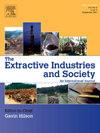Mining-metallurgical monopoly capital in Mexico, 1960–2023
IF 3.6
2区 社会学
Q2 ENVIRONMENTAL STUDIES
Extractive Industries and Society-An International Journal
Pub Date : 2024-09-27
DOI:10.1016/j.exis.2024.101545
引用次数: 0
Abstract
This study analyzes the historical evolution of monopoly capital in the mining-metallurgical sector in Mexico during 1960–2023, focusing on the cases of the companies Grupo México and Industrias Peñoles. The main corporate strategies used to maintain and expand their control are reviewed, as well as the economic policies and legal changes that occurred in parallel with this process, from the Mexicanization of the industry to the implementation of neoliberal policies. It is concluded that the trajectory of mining monopolies is based on the appropriation of growing revenues through land monopolization and the formation of a corporate-government network, leading to an increasing concentration of wealth and the generation of prolonged socio-environmental conflicts.
墨西哥采矿冶金垄断资本,1960-2023 年
本研究分析了 1960-2023 年墨西哥采矿冶金行业垄断资本的历史演变,重点关注墨西哥集团和佩尼奥莱斯工业公司的案例。报告回顾了为保持和扩大控制权而采取的主要企业战略,以及与此过程同时发生的经济政策和法律变革,从行业墨西哥化到新自由主义政策的实施。结论是,矿业垄断的发展轨迹是通过土地垄断和形成企业-政府网络来获取不断增长的收入,从而导致财富日益集中,并引发长期的社会环境冲突。
本文章由计算机程序翻译,如有差异,请以英文原文为准。
求助全文
约1分钟内获得全文
求助全文
来源期刊

Extractive Industries and Society-An International Journal
ENVIRONMENTAL STUDIES-
CiteScore
6.60
自引率
19.40%
发文量
135
 求助内容:
求助内容: 应助结果提醒方式:
应助结果提醒方式:


